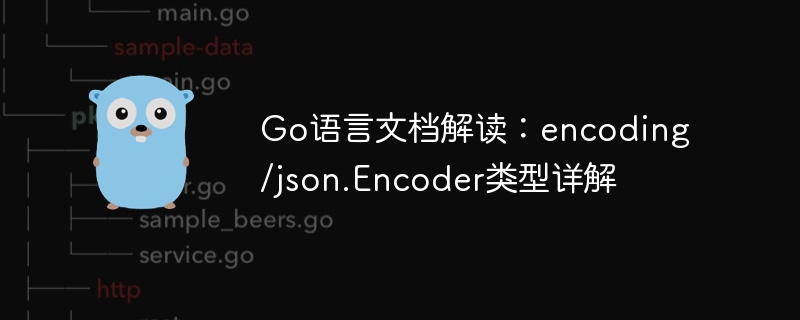

In the Go language, the encoding/json package is a standard library for processing data in JSON (JavaScript Object Notation) format. In this library, an Encoder type is provided, which can encode structures or other data types in the Go language into binary data that conforms to JSON format. This article will explain this type in detail and provide specific code examples.
Let’s first take a look at the definition of Encoder type:
type Encoder struct {
w io.Writer
err error
h *encodeState
generic bool
}As can be seen from the definition, the Encoder type is a struct type, containing the following four Fields:
Encoder type The following methods are provided:
The NewEncoder method is used to create an Encoder type instance and needs to pass in an io.Writer interface object as a parameter . The following is a sample code for creating an Encoder instance:
package main
import (
"encoding/json"
"os"
)
func main() {
type Movie struct {
Title string
Year int
Actors []string
}
movie := Movie{
Title: "Inception",
Year: 2010,
Actors: []string{"Leonardo DiCaprio", "Ellen Page", "Tom Hardy"},
}
encoder := json.NewEncoder(os.Stdout)
encoder.Encode(movie)
}In the above sample code, we create a structure instance of Movie type and encode it and output it to standard output.
The Encode method is used to JSON encode the incoming data type (v) and write the encoding result to In the io.Writer of the Encoder instance object. If an error occurs during encoding, the corresponding error message will be returned. The following is a sample code for the Encode method:
package main
import (
"encoding/json"
"os"
)
func main() {
type Movie struct {
Title string
Year int
Actors []string
}
movie := Movie{
Title: "Inception",
Year: 2010,
Actors: []string{"Leonardo DiCaprio", "Ellen Page", "Tom Hardy"},
}
file, _ := os.Create("movie.json")
encoder := json.NewEncoder(file)
encoder.Encode(movie)
file.Close()
}In the above sample code, we create a structure instance of Movie type, encode it and write it to the movie.json file.
The SetIndent method is used to set the indent format of JSON encoded output. It receives two string parameters, representing "prefix" ” and “indentation”. The following is a sample code for the SetIndent method:
package main
import (
"encoding/json"
"os"
)
func main() {
type Movie struct {
Title string
Year int
Actors []string
}
movie := Movie{
Title: "Inception",
Year: 2010,
Actors: []string{"Leonardo DiCaprio", "Ellen Page", "Tom Hardy"},
}
file, _ := os.Create("movie.json")
encoder := json.NewEncoder(file)
encoder.SetIndent("", " ")
encoder.Encode(movie)
file.Close()
}In the above sample code, we use the SetIndent method to set the indent prefix to empty, indent the string to four spaces, and then format the encoded JSON The data is written to the movie.json file.
The SetEscapeHTML method is used to set whether the Encoder instance object needs to escape HTML tags. The default value is true. If the on parameter is true, the HTML tag will be escaped; if the on parameter is false, the output will be in the original string format. The following is a sample code for the SetEscapeHTML method:
package main
import (
"encoding/json"
"os"
)
func main() {
type Example struct {
Name string
HTMLBody string `json:"body"`
}
example := Example{
Name: "example",
HTMLBody: "<h1>This is a heading</h1>
<p>This is a paragraph.</p>",
}
file, _ := os.Create("example.json")
encoder := json.NewEncoder(file)
encoder.SetEscapeHTML(false)
encoder.Encode(example)
file.Close()
}In the above sample code, we use the SetEscapeHTML method to output the HTML tag into the original string format.
The Encoder type is a core type used for JSON encoding in the encoding/json package in the Go language. It provides encoding processing of JSON format data. Its implementation principle is to Convert structures or other data types in the Go language into binary data in JSON format and output it to the specified io.Writer. When using the Encoder type, we can set encoding parameters, perform JSON encoding and other operations by calling its public methods.
The above is the detailed content of Go language document interpretation: Detailed explanation of encoding/json.Encoder type. For more information, please follow other related articles on the PHP Chinese website!
 Usage of Type keyword in Go
Usage of Type keyword in Go
 How to implement linked list in go
How to implement linked list in go
 What are the Go language programming software?
What are the Go language programming software?
 How to learn go language from 0 basics
How to learn go language from 0 basics
 What are the methods to implement operator overloading in Go language?
What are the methods to implement operator overloading in Go language?
 What are the operators in Go language?
What are the operators in Go language?
 How to insert video in html
How to insert video in html
 How to solve problems when parsing packages
How to solve problems when parsing packages




